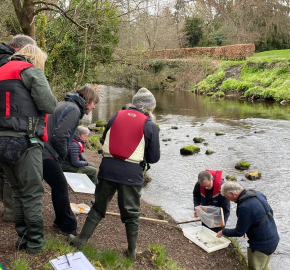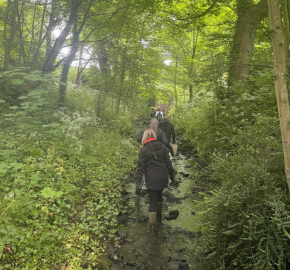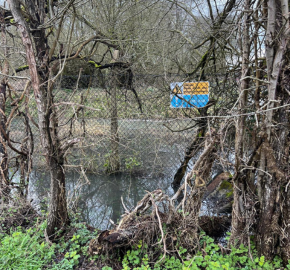Welsh regulator to increase monitoring after SmartRivers discovery
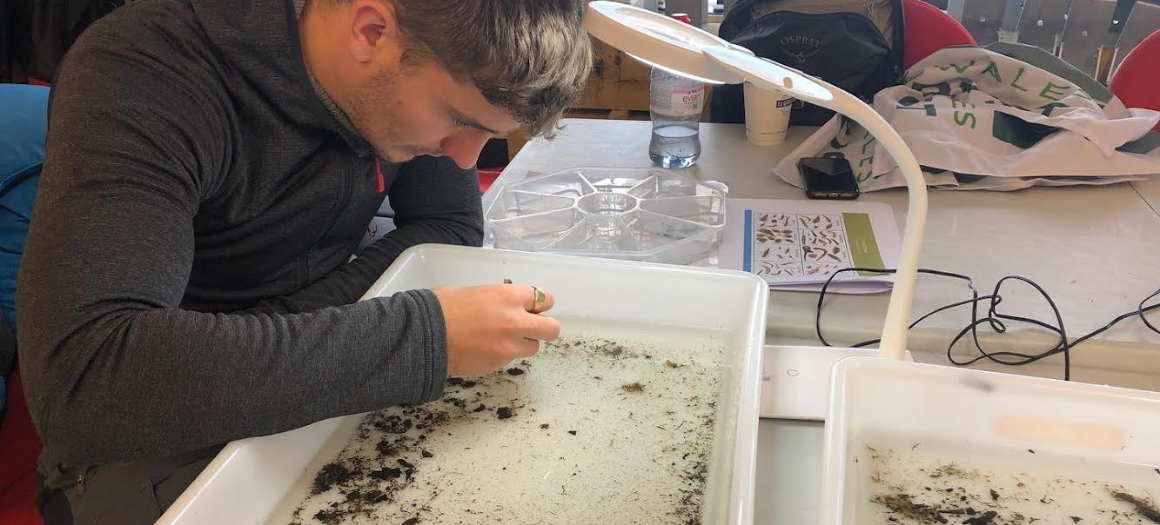
Our water policy officer, James, unpicks the troubled past of the River Cynon and demonstrates how SmartRivers data collected by local volunteers is being used to address new challenges threatening the river and its wildlife.
Torrential rain greeted me the first time I visited our SmartRivers Hub on the Cynon. I’d left London that morning, by train, in beautiful sunshine. My weather app told me that Pontypridd would be dry. I had dressed appropriately in a shirt with smart trousers and shoes. Little did I know how unpredictable the weather could be in the Welsh Valleys.
By the time I was scooped up in a tiny, but mighty, black Peugeot driven by Cynon hub lead, Gareth Edge, I was completely drenched. No umbrella, no rain jacket, no Wellington boots – Gareth must have thought I was a complete fool. Luckily, with the Peugeot’s heater on full whack and the clouds dispersing I was spared from an entire day of blushes.
Of the 64 rivers monitored by our SmartRivers programme, the Cynon has to be one of the most remarkable. For centuries the river has endured heavy industrial pollution but bounced back to support viable populations of water-dependent wildlife. Now its resilience is being tested once again.
A long history of pollution
The Cynon is a tributary of the River Taff. Rising in the Brecon Beacons National Park, it travels a little over 15 miles southeast before joining the Taff which flows into Cardiff Bay. On its way, the river passes through towns and villages including Penderyn, Hirwaun, Aberdare, Mountain Ash and Abercynon – many of which have a long history of heavy industry.
For centuries the river has endured heavy industrial pollution. From South Wales’s first coke-fired iron works, built in 1757, to Towery Colliery (the oldest continuously working coal mine in the United Kingdom) which closed in 2008.
Declines in industrial activity allowed the river to bounce back and more recently it has supported populations of salmon, trout, grayling and kingfishers. In fact, the only time I have ever seen an otter in the wild was during a site inspection on the Cynon. A fantastic little creature bobbing along, on its back in the centre of the river, without a care in the world. I think it almost waved as it passed us by.
But now, the Cynon has a new challenge, part of the river is disappearing before our eyes.
River life faces a new threat on the Cynon
On behalf of South East Wales River Trust, Gareth joined SmartRivers in 2020 to help restore the biodiversity of the post-industrial Cynon Valley. Over the past six sample seasons, we have been able to use SmartRivers data to help identify areas where freshwater invertebrates continue to suffer the effects of pollution along the Cynon. The data has also revealed a new and increasing threat to the upper reaches of the Cynon (Nant Cadlan).
SmartRivers data indicates that river life at the furthest upstream site sampled (Ford at Pont Pren) is under increasing pressure. The expected cause is over-abstraction (the process by which more water is removed than can naturally be replaced) which has resulted in a steep decline in invertebrate populations and a rise in chemical pressure.
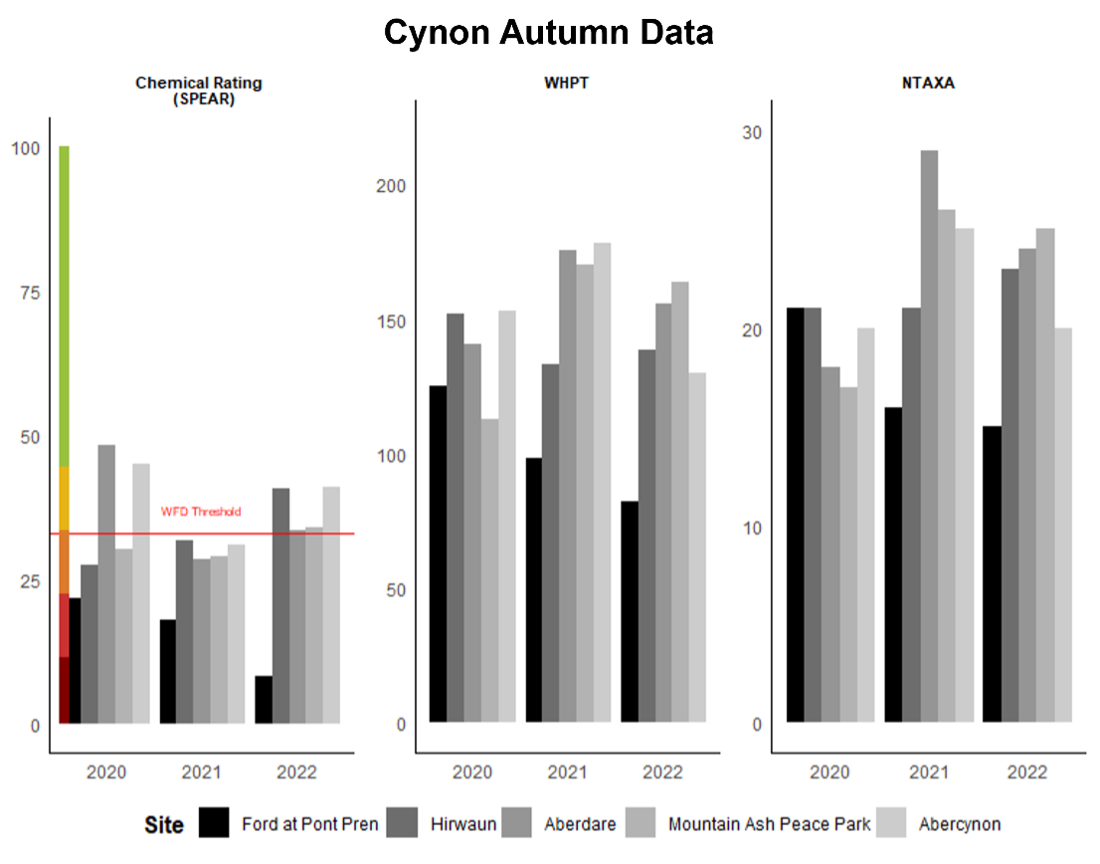
Figure 1: WHPT = Family-level index used for the assessment of freshwater invertebrate communities under the Water Framework Directive. NTAXA = number of invertebrate families contributing to the WHPT score.
Following two site visits we were able to identify three potential culprits: Hanson Quarry, Penderyn Distillery and Welsh Water. During our first stakeholder meeting, local people explained to us, that the drying was a recent phenomenon – but that we should really speak with landowner Susan Gay.
In mid-June 2023, we met with Susan. The farm that Susan lives on has been in her family since 1720 with the Cynon at one of its boundaries. The land supports 400 head of sheep and is highly dependent on the water that flows through the valley. For the first time in 300 years, they ran out of water in 2021.
This was not a natural drought, Susan stressed. Susan is adamant that Hanson’s Quarry has discovered a lagoon that it now pumps – without a permit – which has caused a change in the water table. Susan recounted that in the summer of last year, the local area was without water for three months. Lorries had to transport water from other areas to maintain supplies.
Something clearly isn’t right at the head of the Cynon.
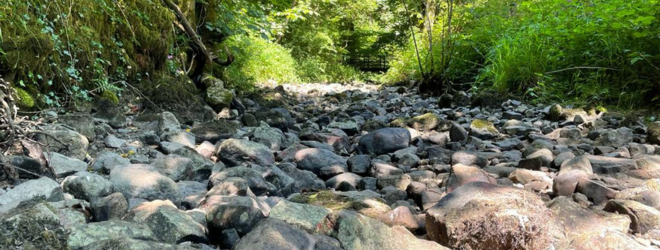
The upper reaches of the River Cynon. ©JamesOverington
SmartRivers data fuelling river protection
Armed with SmartRivers data, site reports and local stakeholder accounts, Gareth and I met with Natural Resources Wales (NRW) this summer. The fact that the Penderyn section of the Cynon was bone dry the day we met played to our advantage.
Following our meetings, local NRW has now applied for funding to study the drying on the Cynon. Progress is seemingly being made. We’ll be watching closely to monitor the intended local action.
A regulator without the tools to do its job
NRW was formed in 2013 by the amalgamation of three Welsh environmental bodies – providing the Welsh government with significant savings. Since 2013, its budget has been reduced by 30%. Back when its staff survey was publicly available, only 10% of staff believed NRW was well managed.
My dealings with NRW support this. In the past 18 months, several staff members have left. Those that remain are under-resourced and find it difficult to conduct their job as they once did.
Meanwhile, Welsh rivers continue to suffer.
In 2020, NRW conducted 947 water quality compliance assessments at 393 sites. NRW found permit breaches in 82% of cases.
The future of the Cynon
My time spent in the Cynon Valley has given me faith that the river will recover, largely thanks to the local communities invested in its protection.
Many have shared their stories with me. Neil Wroblewski, from Cwmbach Community Wetlands, is one such individual and he certainly won’t pull any punches when his stretch of the river is in danger. Elsewhere, Gareth Edge continues to work hard to engage young people in schools and at community events – to inspire the next generation of river guardians.
SmartRivers will continue to work as an early warning system – identifying pressures as they evolve. The results gathered will support local community action and feed into our lobbying efforts to restore nature and natural flows to the Cynon.
WildFish will work alongside the Cynon SmartRivers volunteers wherever it can and I look forward to my next visit, this time armed with an umbrella!


